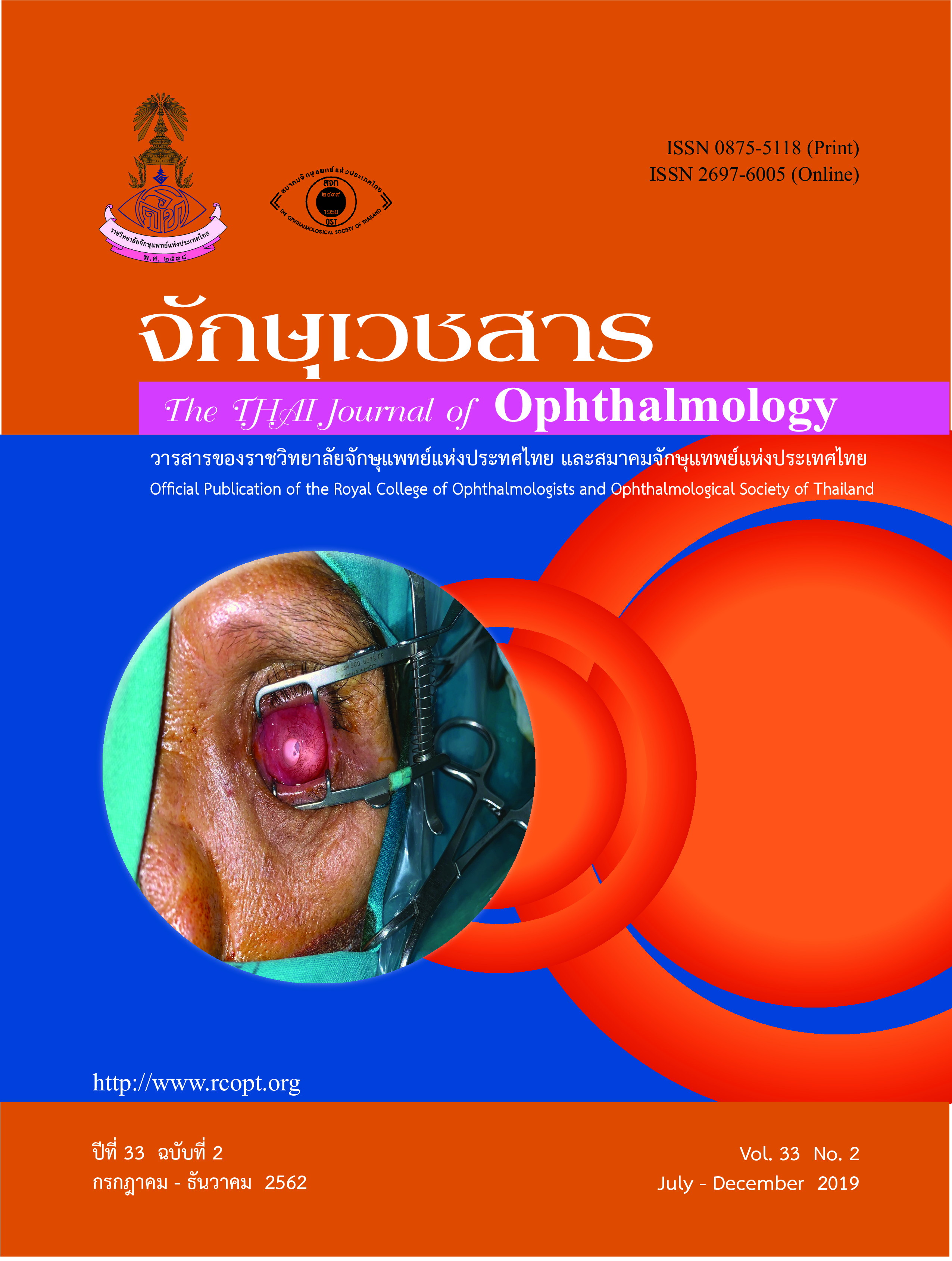Patterns of Hydroxychloroquine and Chloroquine Retinopathy in Thai patients
Abstract
Abstract
Purpose: To evaluate patterns of Hydroxychloroquine (HCQ) and Chloroquine (CQ) retinopathy in Thai
patients.
Methods: Retrospective observational study. We reviewed the medical records of patients taking HCQ and
CQ who visited ophthalmology department at Ramathibodi Hospital for retinopathy screening during 1st
January 2016 to 31st December 2016. The baseline characteristics and imaging tests consisting of spectral
domain optical coherence tomography (SD-OCT), computed tomography visual fields (CTVF), and fundus
autofluorescence (FAF) were reviewed for evidence of drug-induced retinopathy. Retinopathy patterns
were classified as parafoveal (retinal changes within 2-7 degrees from fovea or within central 2.5mm),
perifoveal (retinal changes> 8 degrees from fovea), and combined (retinal changes in both parafoveal
and perifoveal area).
Results: Among 933 patients screened in 2016, 2.59% (20 of 773) and 20.63% (33 of 160) were diagnosed
with toxicity in HCQ and CQ group, respectively. Of total 20 patients with HCQ retinopathy, 70% (14 of
20) had typical parafoveal pattern, and 30% (6 of 20) had perifoveal pattern. Of 33 patients with CQ
retinopathy, 6 patients with Bull’s eye retinopathy were excluded due to advanced lesion, 81.48% (22 of
27) had parafoveal pattern, 11.11% (3 of 27) had perifoveal pattern, and 7.41% (2 of 27) had combined
pattern. We also noticed that patients with perifoveal pattern, though were the minority, were often
delayed diagnosed due to previously unrecognized pattern of retinal damage.
Conclusions: Parafoveal pattern was predominant among Thai patients in both HCQ and CQ group.
Perifoveal pattern was more prevalent in HCQ than CQ group. Appropriate screening exam with wideangle
image would help in early detection of perifoveal retinopathy.
References
Melles RB, Marmor MF. The risk of toxic retinopathy in patients on long-term hydroxychloroquine therapy. JAMA Ophthalmol 2014;132:1453-60.
Marmor MF, Kellner U, Lai TY, Melles RB, Mieler WF, American Academy of: Ophthalmlogy. Recommendations on Screening for Chloroquine
and Hydroxychloroquine Retinopathy (2016 Revision). Ophthalmology 2016. Ophthalmology 2016:123(6);1386-94.
Kellner S, Weinitz S, Farmand G, Kellner U. Cystoid macular oedema and epiretinal membrane formation during progression of chloroquine retinopathy after drug cessation. Br J Ophthalmol 2014;98(2):200-6.
Marmor MF. Comparison of screening procedures in hydroxychloroquine toxicity. Arch Ophthalmol 2012;130(4):461-469.
Melles RB, Marmor MF. Pericentral retinopathy and racial differences in hydroxychloroquine toxicity. Ophthalmology 2015;122:110-6.
Lee DH, Melles RB, Joe SG, et al. Pericentral hydroxychloroquine retinopathy in Korean patients. Ophthalmology 2015;122:1252–6.
Puavilai S, Kunavisarut S, Vatanasuk M, et al. Ocular toxicity of chloroquine among Thai patients. Int J Dermatol 1999;38(12):934-937.
Leecharoen S, Wangkaew S, Louthrenoo W. Ocular side effects of chloroquine in patients with rheumatoid arthritis, systemic lupus erythematosus
and scleroderma. J Med Assoc Thai 2007;90(1):52-58.
Chiowchanwisawakit P, Nilganuwong S, Srinonprasert V, et al. Prevalence and risk factors for chloroquine maculopathy and role of plasma chloroquine
and desethylchloroquine concentrations in predicting chloroquine maculopathy. Int J Rheum Dis 2013;16(1):47-55.
Nuanpan Tangtavorn, Yosanan Yospaiboon, Tanapat Ratanapakorn, et al. Incidence of and risk factors for chloroquine and hydroxychloroquine retinopathy in
Thai rheumatologic patients. Clin Ophthalmol 2016; 10: 2179-185.
Anderson C, Blaha GR, Marx JL. Humphrey visual field findings in hydroxychloroquine toxicity. Eye (London, England) 2011;25(12):1535-45.
Browning DJ, Lee C. Relative sensitivity and specificity of 10-2 visual fields, multifocal electroretinography, and spectral domain optical coherence tomography
in detecting hydroxychloroquine and chloroquine retinopathy. Clinical Ophthalmology (Auckland, NZ) 2014;8:1389-99.
Downloads
Published
Issue
Section
License
The Thai Journal of Ophthalmology (TJO) is a peer-reviewed, scientific journal published biannually for the Royal College of Ophthalmologists of Thailand. The objectives of the journal is to provide up to date scientific knowledge in the field of ophthalmology, provide ophthalmologists with continuing education, promote cooperation, and sharing of opinion among readers.
The copyright of the published article belongs to the Thai Journal of Ophthalmology. However the content, ideas and the opinions in the article are from the author(s). The editorial board does not have to agree with the authors’ ideas and opinions.
The authors or readers may contact the editorial board via email at admin@rcopt.org.


